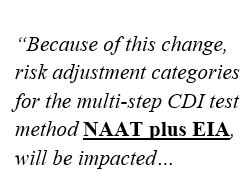by Evelyn Cook, RN, CIC

National Healthcare Safety Network’s (NHSN) Multidrug-Resistant Organism and Clostridium difficile Infection (MDRO/CDI) Module, define CDI-positive laboratory assay as:
- A positive laboratory test result for difficile toxin A and/or B, (includes PCR and/or toxin assays) tested on an unformed stool specimen; OR
- A toxin-producing difficile organism detected by culture or other laboratory means performed on an unformed stool sample.
The NHSN Patient Safety Component-Annual Hospital Survey requires facilities to indicate the primary testing method for C. difficile, used most often by your facility’s laboratory (or by the outside laboratory where your facilities testing is performed).  Additionally, when facilities complete the “MDRO/CDI Prevention Process and Outcome Measures Monthly Reporting” form for the last month of each quarter, users are asked to report the primary type of test that was used to identify CDI in the facility for that quarter.
Additionally, when facilities complete the “MDRO/CDI Prevention Process and Outcome Measures Monthly Reporting” form for the last month of each quarter, users are asked to report the primary type of test that was used to identify CDI in the facility for that quarter.
NHSN uses that test type in the calculation of the Standardized Infection Ratios (SIRs) for C. difficile for that quarter.
A variety of diagnostic tests, used to identify C difficile, are available and testing methods may vary significantly between healthcare facilities. A number of facilities are now using multi-step testing algorithms such as:
- NAAT plus EIA (2 step algorithm)
- GDG plus EIA (2 step algorithm)
- GDH plus EIA for toxin, followed by NAAT for discrepant results
In 2017, all specimens that tested positive for C. difficile were reported to NHSN and SIRs were calculated based on quarterly testing methodology. Refer to example below:
| CDI Test Type (entered quarterly) |
Reporting Protocol 2017 |
Risk Adjustment Category (applied by NHSN) |
| NAAT + EIA, if NAAT positive | Report specimens that tested positive at any point in the algorithm (if NAAT positive and EIA negative, must report) | NATT |
However, as of January 2018 NHSN’s MDRO/CDI Protocol states, “Results of the final test that are placed in the patient’s medical record should be used to determine whether or not the event meets the CDI LabID Event definition”.
Because of this change, risk adjustment categories for the multi-step CDI test method NAAT plus EIA, will be impacted, and may result in a lower number of predicted events (SIR denominator). Refer to the example below:
| CDI Test Type (entered quarterly) |
Reporting Protocol 2018 |
Risk Adjustment Category (applied by NHSN) |
| NAAT + EIA, if NAAT positive | Report specimens that tested positive from the last step in the algorithm (EIA) | EIA |
| GDH + EIA for toxin, followed by NAAT for discrepant results | Report specimens that tested positive from the last step in the algorithm (NAAT) | NAAT |
According to the December 2017 NHSN newsletter, no changes were being made to the risk adjustment categories for any other CDI test method.
In their letter to the editor, “Impact of 2018 Changes in National Healthcare Safety Network Surveillance for Clostridium difficile Laboratory-Identified Event Reporting”, authors noted, “Changes in the event definition for algorithmic C. difficile testing approaches may further complicate the problem by driving laboratories to select testing approaches based upon the NHSN definition rather than on local laboratory and clinical factors”.
References:
Multi-resistant organism and Clostridium difficile infection (MDRO/CDI) module. Centers for disease Control and Prevention
https://www.cdc.gov/nhsn/acute-care-hospital/cdiff-mrsa/index.html
NHSN e-News. Centers for Disease Control and Prevention. Volume 12, Issue 4; December 2017 https://www.cdc.gov/nhsn/pdfs/newsletters/nhsn-nl-dec-2017-508.pdf
Marra AR, Edmond MB, Ford BA, Herwaldt LA, Algwizani AR, Diekema DJ. Impact of 2018 Changes in National Healthcare Safety Network Surveillance for Clostridium difficile Laboratory-Identified Event Reporting. Infect Contol Hosp Epidemiol 2018; 39:886-887